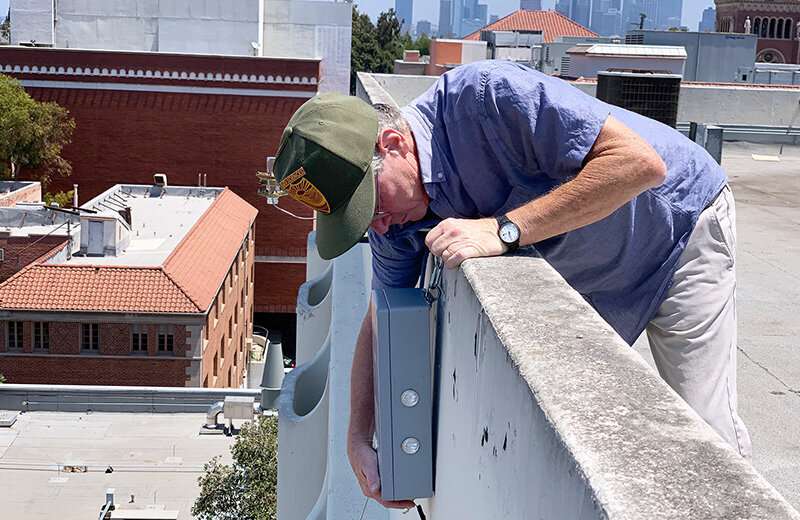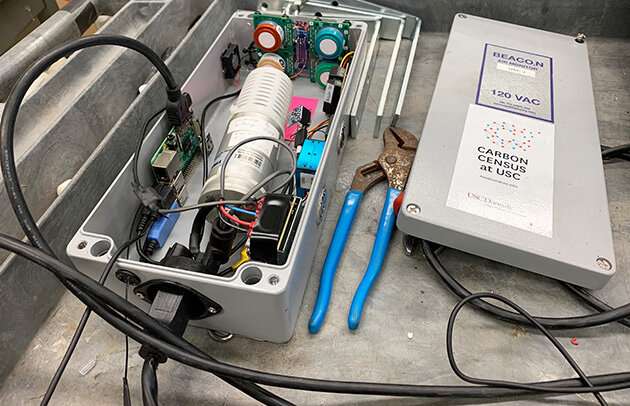Sensor network aims to measure carbon dioxide and pollutant levels in Los Angeles

They look simple enough, light gray and about the size of a loaf of bread. On their face, a label sports a colorful "C" stylized to resemble a molecular structure along with the words "Carbon Census at USC."
Inside the metal boxes, a highly sophisticated package of electronic sensors sniffs the surrounding air for an array of pollutants. The climate-warming gas carbon dioxide, its suffocating cousin carbon monoxide and various nitrogen oxide-containing compounds, the type that turn the Los Angeles air hazy orange and brown, rank high among the noxious air components.
The sensors also detect particulate matter—microscopic bits of smoke, soot, dust and other harmful compounds—and ozone, and they measure air temperature and humidity.
The boxes are part of a network assembled by William Berelson, professor of Earth sciences and environmental studies at the USC Dornsife College of Letters, Arts and Sciences, to map air quality in various L.A. neighborhoods.
From one sensor to a city-wide network
It started with a single sensor Berelson uses in his lab on USC's University Park campus. "I have a CO2 and methane analyzer and have been measuring air from the rooftop of my lab building for a few years," he said.
When he heard about a network of sensors that monitor air quality in Berkeley, California, Berelson "thought it would be great to do a similar network in L.A.," he said. He now has 12 sensors distributed at Los Angeles Unified School District sites, USC's campuses and other locations.
Berelson has a number of ambitions for his carbon sensor network. First, he wants to map air quality on a neighborhood scale to determine if and how the concentration of the assorted pollutants changes over time and in various locations.
"For example, is carbon monoxide always higher at sites near freeways—does truck traffic drive CO concentration? That hypothesis is based on the fact that CO forms in combustion engines," he says, and his sensors can help determine if that belief is correct.
Berelson also aims to find out if levels of particulate matter—particularly the dangerous "PM2.5"—are higher or lower in regions of the city with more trees and plants because, he says, "vegetation can sometimes 'sponge' PM from air, but they can also make the organic precursors of PM." The project contributes to USC's Urban Trees Initiative, a collaborative project led by USC Dornsife's Public Exchange designed to assist L.A. Mayor Eric Garcetti's goal of planting nearly 100,000 trees throughout the city.
A key function of Berelson's carbon sensor network will be to establish the current levels of CO2 throughout L.A. so researchers, policy makers and others can clearly see the effects of moving to more eco-friendly practices, such as driving electric vehicles, riding mass transit or tele-commuting for work.
"We want a good baseline set of CO2 measurements so we can see how CO2 content in L.A. air is changing over time and, perhaps, due to changes in social behavior," he says.

Berelson says the project offers plenty of opportunities for students to contribute and learn. Currently, Emma Johnson, a junior majoring in geological sciences at USC Dornsife, is developing software for the sensors that will be used for the Urban Trees Initiative. Berelson says a high school student is also working with his group and he expects more undergrads to join in the fall.
In the long term, Berelson hopes to add more sensors and expand the L.A. network, but he also wants to develop networks in other cities if he can obtain the needed funding. He's already begun planning with Joshua West, professor of Earth sciences and environmental studies, and Ron Cohen, the University of California, Berkeley professor who runs the Berkeley network that inspired Berelson.
"We'd like to expand our network in L.A. for sure," says Berelson. "Ron and Josh and I have talked about growing networks in Phoenix and Seattle/Portland to consider West Coast urban CO2 dynamics in cities that feel very different water and heat stress," Berelson says.
With these added networks and his L.A. system, Berelson could give policy officials and decision-makers the data they need to develop effective strategies to combat climate change and promote healthier air quality.
Provided by University of Southern California





















